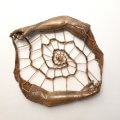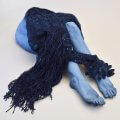
Red Lodge Clay Center – Short-Term Resident (AIA) 2024
Sara Torgison (San Diego, CA b. 1987) is an interdisciplinary artist with a focus in ceramics and fiber art. She received an MFA from the University of Cincinnati Department of Design, Architecture, Art and Planning and a BFA from Cal Poly Humboldt in Arcata, CA. Sara is currently visiting faculty at Miami University in Oxford OH and works as a preparator at the Cincinnati Contemporary Art Center. She recently completed a residency at the Penland School of Craft and is a 2023 Ohio Arts Council Creative Excellence Grant recipient. Her work is widely exhibited and collected throughout the United States.
Working between ceramic, fiber, and found materials, I build onto and extend finite and fragile surfaces to emphasize and inhabit marginal spaces. Strange alliances formed in passages between hard and soft substances are resonant of the shifts inherent in navigating public and private life and the distance between self and other. The action of configuring bridges in transitional zones draws upon traditions of mending and maintenance as a continuous collaborative process. My work explores themes of fracture, flexibility, and holding space for dissonance and discomfort necessary for individual and collective growth and healing.
My process generally begins with movement of clay materials through impression back and forth between hands and medium. This interplay is bi-laterally suggestive. How I create an animal or figurative element and where fissure or margin begins are directly informed by how the clay moves in my hands, and by what I can reasonably expect it to do in the kiln. I forage materials to dye fiber for crochet and knit processes. My interests in traditional knowledge and sustainable sourcing creates a shifting availability of colors and textures and bolsters the complexity of material relationships interacting within each work.
Creating with animal figures allows for a more-than-human dialogue in considering emotionally difficult concepts. These “Model Organisms” (a scientific term for animal alternatives to human biology in research settings) become visual vehicles, interrogating the nature of exploitation and societal values around life, consumption, and death. Figures are physically tethered; hanging, sitting, or attempting to escape, yet bound to a shared fate. These works form questions as I explore each form: Who are we without each other? How can we honor all life lived in relation to culture and ecology? Each assembly of strained interdependence becomes a container of complicated and unseemly histories and futures.






